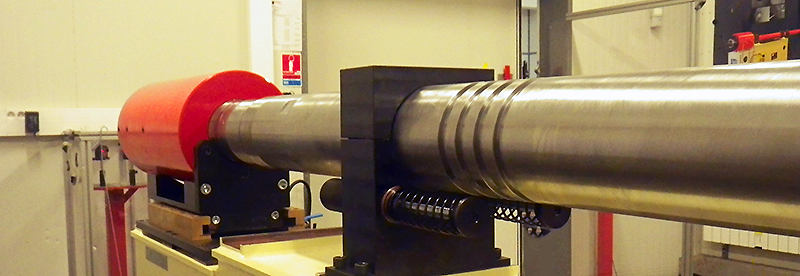
In the very near future, the THIOT INGENIERIE shock physics laboratory will be receiving a rather unique laboratory launcher: the CHRONOS acceleration/deceleration generator. This launcher has been designed in particular for studying the behaviour of embedded electronics in highly stressed systems.
- 1 g = 9.81 m/s2
- Train starting to move: 0.1 to 0.2 g
- Intense roller coasters: 3.5 to 6.3 g
- Formula 1 race car, maximum lateral acceleration in a bend: 5 to 6 g
- Rafale fighter aircraft in a turn: 11 g
- Sudden deceleration of a car travelling at 130 km/h: 36 g
- Acceleration of the Sprint anti-ballistic missile: 100 g
- Artillery shell: between 15,000 and 30,000 g
An acceleration/deceleration generator
From its appearance, you could take it for one of the laboratory gas launchers THIOT INGENIERIE has been designing for nearly 30 years. However, it is nevertheless completely new. Its distinctive features lie in the fact that the barrel is closed at both ends and that the test specimen is recovered with ease. A projectile (or canister) containing embedded electronics or a micromechanical system, for example, is inserted into the acceleration tube. The projectile will undergo progressive acceleration and then deceleration, according to a pre-programmed profile.
What are the end-purposes?
CHRONOS will make it possible to test the behaviour of the electronics during these extreme acceleration and deceleration phases, in which the forces can reach 100,000 g. By means of comparison, keep in mind that a fighter aircraft pilot can withstand an acceleration force of 11 g. The main applications will be in the military sector, particularly for missile manufacturers, but can also be extended to the aeronautics and space sectors.
In addition to being able to offer our customers test services using our own acceleration/deceleration generator in the THIOT INGENIERIE laboratory, we can also design and deliver this type of test equipment.
John Stapp, acceleration/deceleration test pioneer
John Paul Stapp (1910-1999), was a colonel in the US Air Force and had a PhD in biophysics. He was one of the first people to study the effects of acceleration and deceleration on the human body. And to do this, he himself acted as guinea pig in 29 experiments, convinced that the human body could withstand more than the American armed forces thought it could. To evaluate the effects of deceleration and to improve pilots’ equipment, Stapp ordered the design of a rocket-propelled sled running on tracks. He established his record in 1954 when his rocket-propelled sled reached a speed of 1000 km/h in five seconds before it stopped in 1.4 seconds. His body was thus subjected a deceleration force of 40 g, a shock equivalent to that of a car hitting a wall head-on at over 100 km/h. John Stapp lived to the age of 89, but these tests nevertheless had irreversible effects on his vision.
Video of John Stapp’s record:
